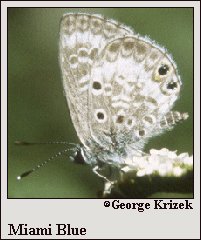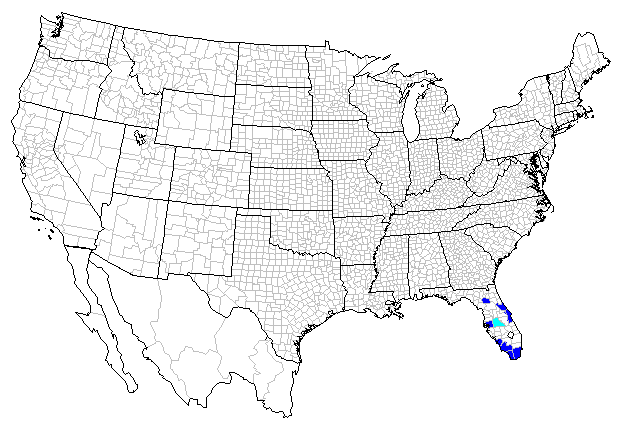 |
 

 |



Miami Blue (Hemiargus thomasi Clench)
Wing span: 7/8 - 1 1/8 inches (2.2 - 3 cm).
Identification: Upperside mostly blue; female hindwing with orange spot at lower edge. Underside of both sexes with 2 eyespots on the outer margin and a wide white submarginal band.
Life history: Eggs are laid singly on flower buds of host plant. Caterpillars feed on flowers and may live inside the pods, eating seeds.
Flight: Throughout the year in Florida. Adults are in reproductive diapause during the winter generation from December-April.
Caterpillar hosts: Balloon vine (Cardiospermum halicacabum) in the Sapindaceae family, possibly snowberry (Chiococca alba), and various legumes.
Adult food: Flower nectar.
Habitat: Openings and edges of tropical hardwood hammocks.
Range: Florida Keys and West Indies. Formerly in southern peninsular Florida.
Conservation: Loss of habitat due to urbanization has extirpated this butterfly on the Florida mainland. All Florida Keys populations should be protected.
The Nature Conservancy Global Rank: G3 - Very rare or local throughout its range or found locally in a restricted range (21 to 100 occurrences). (Threatened throughout its range).
Management needs: Preserve habitats of balloon vine and nectar sources.
References:
Opler, P. A. and G. O. Krizek. 1984. Butterflies east of the Great Plains. Johns
Hopkins University Press, Baltimore. 294 pages, 54 color plates.
Opler, P. A. and V. Malikul. 1992. A field guide to eastern butterflies. Peterson
field guide #4. Houghton-Mifflin Co., Boston. 396 pages, 48 color plates.
Scott, J. A. 1986. The butterflies of North America. Stanford University Press,
Stanford, Calif. 583 pages, 64 color plates.
Author: Jane M. Struttmann

